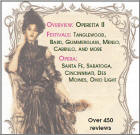Texte paru dans: / Appeared in: |
|
|
Outil de traduction ~ (Très approximatif) |
|
|
Reviewer: Peter
Loewen
The quality of these
performances is exceptionally high. Roughly a third of the works are played
by an ensemble of plucked nd bowed instruments (lute, harp, vielle, rebec,
viola d’arco). To set off Tinctoris’s style, Romain has included Robert
Morton’s rondeau ‘Le Souvenir de Vous Me Tue’ and two of Tinctoris’s
variations on it. Ockeghem’s rondeau ‘Dung Aultre Amer’ is at the center of
another set of variations by Francesco Spinacino, Alexander Agricola, and
Tinctoris. The anonymous ‘Ou Lit de Pleurs Tres Agrevé’ is outstanding among
the works on this recording. I agree with David Fallows that is unlike
anything else from this period. Its counterpoint is chordal, which shows off
the unusual juxtaposition of progressive and retrospective characteristics.
Emphasizing double leading-tone cadences in a texture like this reminds me
of the ‘Gloria’ and ‘Credo’ movements of Machaut’s Mass, composed roughly
100 years earlier. And yet, the rich triadic sonorities seem to anticipate
the music of the late 16th Century.
To compare, one might listen
to another excellent recording of Tinctoris’s music by Voces Aequales (Hungaroton
32583; M/A 2009). | |
|
|
|
|
Cliquez l'un ou l'autre
bouton pour découvrir bien d'autres critiques de CD |
|




